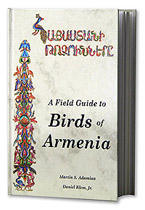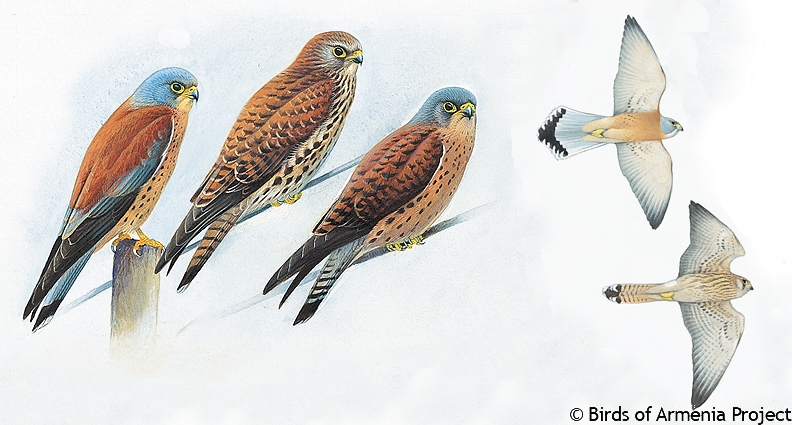- Pictures of All Birds
- Find Bird by Common Name
- Find Bird by Scientific Name
- Find Bird by Armenian Name
- Orders of Birds
- Distribution Maps
- Location of Armenia
- Species of Special Concern

Purchase the Field Guide
© Copyright Birds
of Armenia Project

| Armenian Name: | Տափաստանային հողմավար բազե |
|---|---|
| Species Status: | Endangered Species - Species of Special Concern |

See Plate 11 for Lesser Kestrel and other similar species See Plate 15 for Lesser Kestrel and other similar species in flight
| Flight Characteristics: | Long bluntly-pointed tail with dark subterminal band and slightly longer central tail feathers. Male has blue-gray head, whitish underwings, and pale blue-gray tail base. Female and juvenile have lightly-spotted underwing coverts, and faintly-barred flight feathers. Flies with short rapid wingbeats. Hovers infrequently. Often seen in small flocks perched on wires. |
|---|---|
| Resident Status: | Breeding bird |
| Abundance: | Uncommon |
| Length: | 29-32 cm, Wing Span:58-72 cm |
| Distribution Map: | Map 53. |
| Description: | Slim falcon with white claws. Tip of closed wing almost reaches tail tip; central tail feathers protrude slightly. Male has blue-gray head, greater wing coverts, and tail; unspotted reddish-brown back, and sparsely spotted underparts. Female is red-brown with dark spots and streaks above; dark streaks below. |
| Immature: | Immature male is spotted above with barred tail. |
| Similar Species: | Differs from Common Kestrel by smaller size, white claws, lack of bold mustache mark, and protruding central tail feathers. Male Common Kestrel has spotted back and no blue-gray on wings. |
| Behavior: | Often gregarious. Hunts in open areas; hovers less with faster wingbeats than Common Kestrel. Often perches on telephone poles. |
| Habitat: | Semidesert, mountain steppe near cliffs. |
| Food: | Insects, lizards, other small animals. |
| Nest: | Slight depression in cavity opening in cliff, ravine, or building. |
| Eggs: | 35 mm, 3-5, white, orange spots |